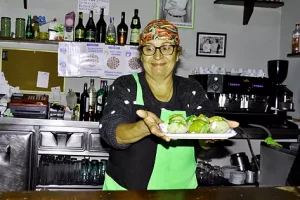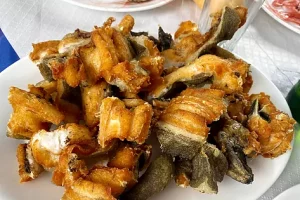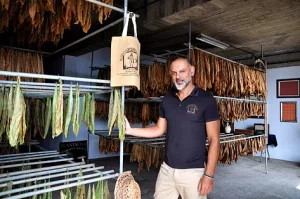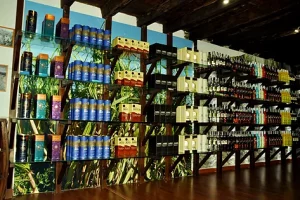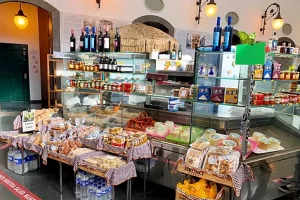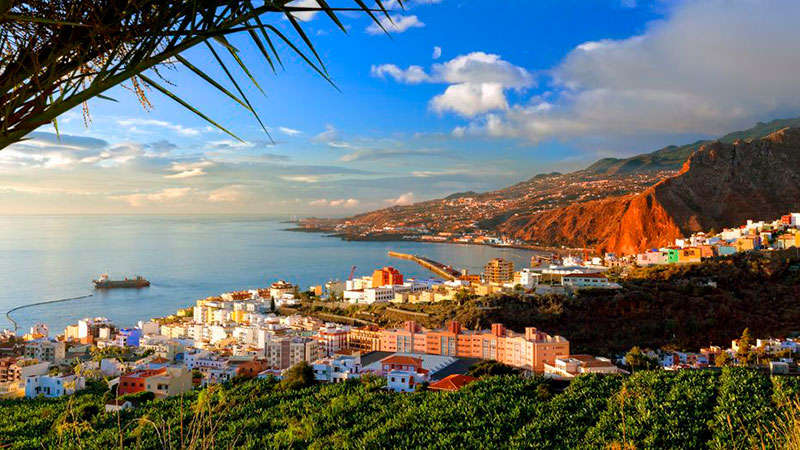
10 Jan Five unique things you can do on La Palma without feeling the volcano
"La Palma offers so many attractions in 700 square kilometres that you can come for a week, not do the Volcanoes Route or visit the Caldera de Taburiente and still have so much to see that the trip will be worthwhile". This is Julio Marante, president of the Association of Tourist Guides of La Palma, who uses two of the most emblematic places on the Isla Bonita to give future visitors an idea of the potential of this "miniature continent". Because although it now seems impossible to separate it from the Cumbre Vieja volcano, the truth is that in most parts of the island its presence is not felt beyond the ashes. But this is not the image that reaches the mainland and abroad, which means that the areas that are not affected by the volcano are practically empty when they should be enjoying their high season in terms of tourism. We take a look at some of these must-see sites.
TASTE JUANA'S GRATEFUL POTATOES
In the middle of Bosque de los TilosFor many people the most beautiful place in the Canary Islands, Joan is the queen. Of the birds that swoop down to eat from her hand every time she leaves the bar. Demetrio House (Bosque de los Tilos, San Andrés y Sauces, s/n) and of the visitors who come to taste their grateful potatoes accompanied by a quart of wine or a beer, either Dorada or Tropical, which she has both. Originally from Tenerife, she moved to La Palma for love, and there she would end up finding the deserved recognition for her star dish. "One day I put some wrinkled potatoes with a little bit of mojo as a tapa and I said to myself 'how dry this is'. But later I put on a white cheese with red mojo and coriander and it was very tasty. So I opened the potato and put the melted cheese in it. Then I looked at it, I thought I had to give it a name and I said: 'this potato is grateful'. And that's how it stayed", he explains. It is likely that anyone who comes to this restaurant located in a Unesco Biosphere Reserve since 2002, the setting for series such as The Witcher thanks to the beauty of places such as its waterfall, end up adding to the tasting its famous goat meat and listen to Carmen questioning his sister as to whether she came to this corner of the archipelago for the mojo palmero or for the chorizo de perro.
EATING MORAY EEL AND SHRIMPS AT CASA GOYO
In this restaurant it is difficult to choose two dishes, even if only to headline a headline. Because in Goyo House (C/Lodero 120, Villa de Mazo) the fish is religion. Just five minutes from the AirportIts origin is closely linked to it, as it was the construction of the latter that led to the creation of a place to provide food for the workers in 1966. Little by little, word of mouth forced the owners to ask for the relevant permits to extend it, which led to the construction of two palm huts. In the long run, its huts would end up giving the place a unique idiosyncrasy: although it has a terrace and normal dining rooms, it is worth eating in its small rooms, where the customer feels as if he were in a private room. The limpets, octopus salpicón, the tollos (aubergines) y the grilled cheese are other of its star dishes, without forgetting its desserts, where the pineapple cream stands out, the mousse of gofio and its popular house coffee dessert.
VISIT PURE CRAFTSMEN JULY
To those who visit Pure Artisan Cigars July (C/ Cabaiguán, 14. Breña Alta) el tabaquero José Julio Cabrera tells them how tobacco is dried, how it is grown, how it is made "and whatever else is needed". This guardian of the essences of the palmero cigar, a lover of decoration (the rooms maintain the aroma of the small workshops called chinchales) and of narrating the history of this product, is also a great lover of the cigar. premium. "For us, ageing is key," he says. "Our legs five or six years, because the best ingredient our cigars have is time. It's very important that we pack it up and leave it for as long as it takes. That's how a business like this can succeed," he says. The tradition took its first steps in this family (there are about six of them left on the island) in 1950. Now, their future goal is to be able to organise visits to their plantation, located in "the area of Cuatro Caminos, towards Socorro". While they prepare for this, they proudly show off their status as cultural treasure for the islandable to keep a historical practice alive thanks to a culture of back and forth with Cuba and the climate of Breña Alta, bathed by the trade winds. Of course, no need to keep your cigars in the fridge, as is sometimes recommended. The best place is inside a piece of cedar furniture.
DRINKING VILLAGE RUM AT ITS DISTILLERY
The Ron Aldea (Camino el Melonar, 19. Charco Azul) was founded in 1936 by Manuel Quevedo Alemán (1872-1968) in Aldea de San Nicolás (Gran Canaria). It was not the best year: the Spanish Civil War meant that the 100,000 bottles ready to export were to stay (and drink) on the island. But the Quevedos were not a family to back down in the face of adversity. That is why, in 1969, when sugar cane cultivation was not profitable in Gran Canaria, they moved to San Andrés y Sauces, in La Palma. There they remain, run by the fourth generation, the still that Don Manuel found in a junkyard in 1893, unique in the world. Thousands of bottles of this rum continue to be produced every year. agricultural style (or French) made only from guarapo, which, although it accounts for only 5% of world sales, is attracting more and more people because of its taste and its reputation for no hangover. Visitors can visit its museum, its facilities and taste before buying the different varieties: Maestro, Familia, Single Cane, Aborigen Caramel Extreme, Ron Miel...
SHOPPING AT LA RECOVA
A Arquemazo semi-cured goat's cheesea Vega Norte red wine, a couple of peppers to make mojo or some almendrados (or rapaduras(if you have a sweet tooth). If you want to buy the best products from the island, you should visit La RecovaThe centenary municipal market of Santa Cruz de la Palma. Built on the site of the former Dolores HospitalThe market has a Renaissance style and an elegant and refined central skylight, which brings natural light to the whole area. Remodelled in 2005, the market has 13 stalls, 12 stalls and several signs that tell its history. And next to it, in what used to be the oratory of the Hospital de Dolores, as if it were a member of the corps, stands the Teatro Chicoopened in 1871 for circus shows and cockfighting.
Source: El Mundo

